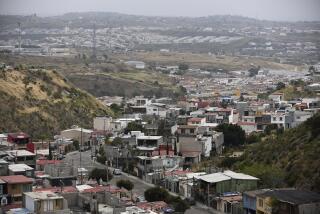Popular with tourists in Brazil, Recife is deadly for residents
Ines Maria da Silva stares blankly outside her shack as she tells how she lost all five of her sons to the violence that makes Recife the deadliest major city in Brazil.
The first son died 15 years ago in a fight over a girl, another after telling a mob he didn’t want a pedophile lynched on his doorstep. The third was stabbed while arguing with a friend and the fourth was shot, mistaken for a thief.
Her last remaining son was felled by a stray bullet as he joined Recife’s famous carnival celebrations a year ago.
“I just want to understand, how come no one is punished?” said the diminutive, 68-year-old widow, who cares for six grandchildren and three unemployed daughters and collects cans and bottles, along with garbage to feed her pigs in Recife’s squalid Coque shantytown.
“There are people here who just kill for fun,” Da Silva said. “Two of the men who killed my sons are my neighbors. If I had somewhere to go I would have moved out a long time ago.”
This seaside city, a favorite with European tourists, gets much more attention for the shark attacks that have killed 18 people since 1992 than for its homicides -- at least 2,617 in the metropolitan area last year.
Tourists are warned not to take valuables to the beaches, as in most Brazilian cities, but little is said about the homicide rate, mostly because the violence generally is restricted to the poor areas.
Although Rio de Janeiro’s bloody drug war makes international headlines, the homicide rate in this balmy city of 1.5 million is 90.9 per 100,000, more than twice that of Rio, according to the Latin American Technological Network’s Map of Violence.
Now, a group of local crime reporters is working to show the human cost of the death toll.
“For 10 years we’ve been writing the same story, all that changes are the names of victims and the killers and the authorities giving the excuse of the moment,” said Joao Valadares. “It’s going to change only when people become aware of the situation, not just when it arrives at their door, but when they realize these are people who are dying.”
Valadares and three of his colleagues have launched www.pebodycount.com.br, featuring a death-toll counter updated daily with details of homicides across Pernambuco state. As of Monday, this year’s count was 1,403. The reporters are working with another website that uses Google Map technology to mark the location of each killing with a red flag.
The group also used red paint to draw outlines of bodies at a month’s worth of crime scenes -- 80 in October alone. And the group plans to inaugurate a body count clock Wednesday on one of Recife’s busiest avenues, Rua Joaquim Nabuco.
“What’s going on here is effectively social cleansing,” said Eduardo Machado, one of the group’s founders. “The vast majority of victims share the same profile: poor, black men between 15 and 30 living in the outskirts and killed by a .38 revolver.”
More than 40% of the homicides are committed by death squads, clandestine groups of off-duty and former police officers who are dedicated to executing undesirable elements, said Jose Luiz Ratton, a sociologist who advises the governor on violence.
Other motivations include rural machismo -- a culture of honor and revenge killings, Ratton said.
“In Rio de Janeiro, the problem is organized crime,” he said. “Here, the problem is disorganized crime.”
Ratton has compiled a plan for how the state government might begin to combat the violence, but little of it has been implemented.
The killings are front-page news only on the rare occasions when middle- or upper-class people are the victims. But each night’s carnage is fodder for the city’s three popular TV crime shows, whose announcers compete to narrate the details with a mixture of indignant bombast and gory glee.
The TV crews won’t go to the scenes until police have arrived, for fear of being attacked. And shantytown dwellers don’t volunteer many details to outsiders.
“Here if you know too much, you die,” said a man who would give only the nickname “Biscoito,” or biscuit, as he watched the journalists refreshing a faded red silhouette.
This “law of silence” is a frustrating reality for police inspector Cleonice Bezerra de Araujo, a 24-year veteran who deals with three to 11 killings a night as she runs the city’s homicide task force.
“Sometimes if it’s a child who’s killed or a woman, a mother, it will still shake me up. But the sad thing is you get used to it,” she said after a mostly fruitless half hour trying to discover how 35-year-old Aldivan Joaquim dos Santos ended up dead on the sidewalk.
Crowds of onlookers gathered and kids on bicycles swerved to avoid the body, spread-eagle on the sidewalk. But even the victim’s wife said that she saw nothing.
An hour earlier, Araujo was investigating the case of a man hacked to death with a machete in a mud hut on the outskirts of town. Neighbors there said they didn’t know the victim, and couldn’t even say how many people lived in the hut with him.
The only lead came as a rumor, that the man had been arrested days earlier for stealing some fruit, casting suspicion on local vigilantes known informally as the “whistle squad.”
But like 90% of the killings in Recife, Araujo said the case wouldn’t get more than a cursory investigation. The killers probably will never be found, much less punished.
State security secretariat spokesman Joaquim Neto acknowledged that the homicide rate is high but pointed out that killings are down 6% this year, which he attributes to his department’s success in dismantling 13 death squads.
He also said Recife’s homicide rate was high compared with other cities only because his department counted them more accurately.
“Other states don’t count police killings as murders or sometimes they count seven people murdered in a single incident as just one killing,” Neto said. “We don’t do that.”
That’s cold comfort for Ines Maria da Silva.
“The police don’t do anything about the violence. Maybe they throw people in jail, but when those people get out of jail they have no right to work, so they rob,” she said wearily.
More to Read
Sign up for The Wild
We’ll help you find the best places to hike, bike and run, as well as the perfect silent spots for meditation and yoga.
You may occasionally receive promotional content from the Los Angeles Times.






